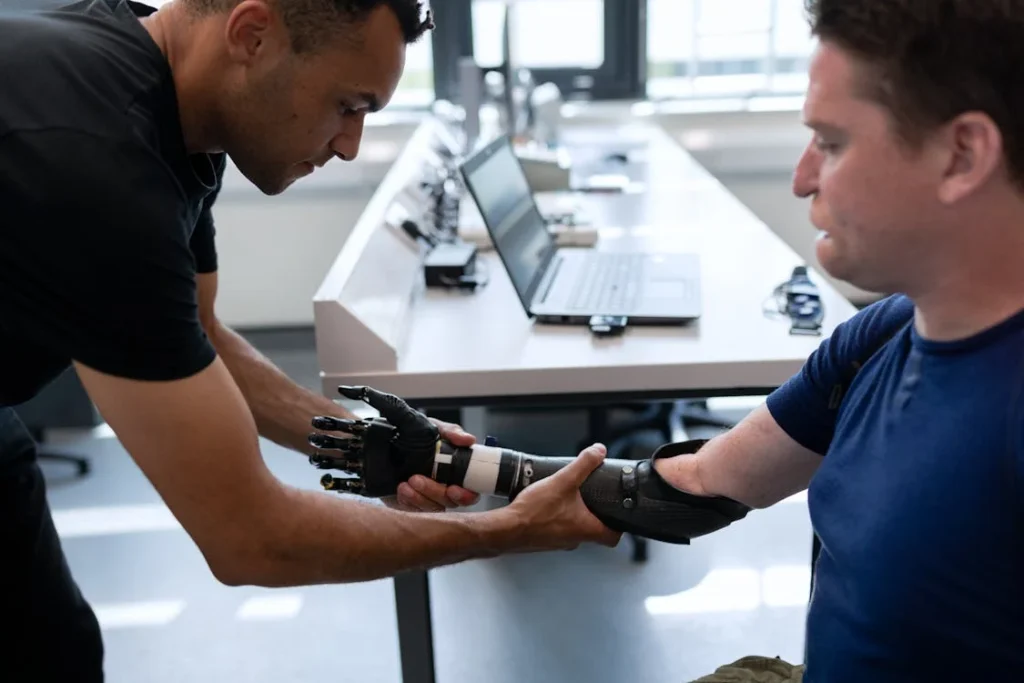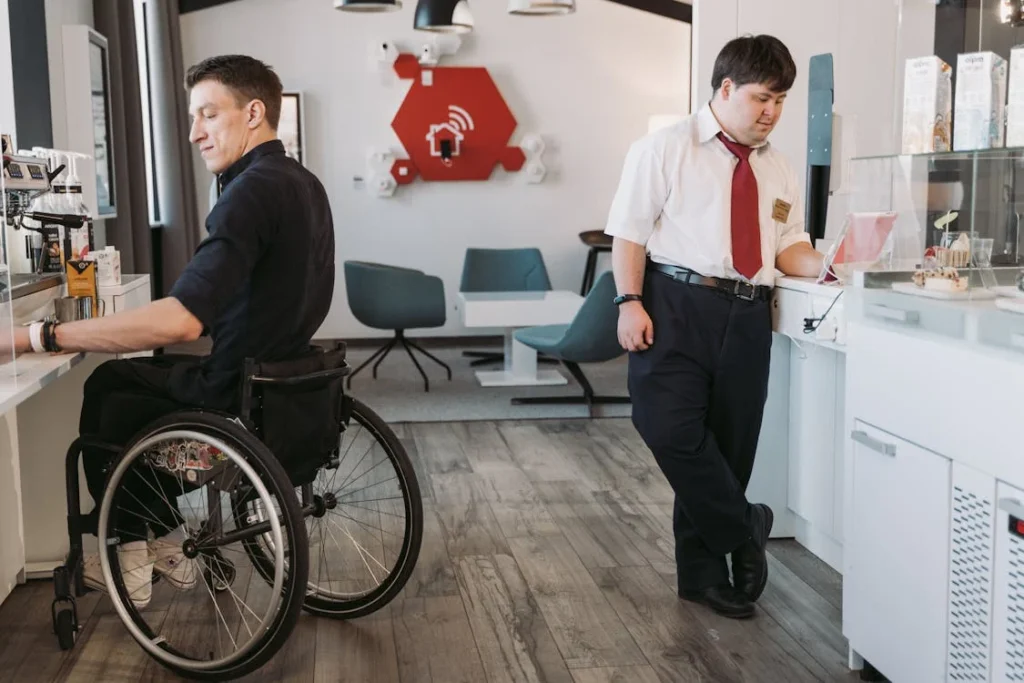Going back to work after an amputation can feel overwhelming, but it is an important step in reclaiming independence. Whether you were in a physically demanding job or worked in an office, adapting to the workplace with a prosthetic limb or mobility aid requires patience, planning, and the right support.
Many people worry about whether they will be able to perform their job as before. The good news is that with the right approach, most amputees successfully return to work—sometimes even stronger than before. The key is preparation, proper rehabilitation, and understanding your rights and workplace accommodations.

Preparing Physically and Mentally for Work
Returning to work after an amputation requires both physical readiness and mental confidence. The body must be strong enough to handle the demands of the job, while the mind must be prepared for new challenges.
Recovery takes time, and each person’s journey is different. Some may be eager to return within a few months, while others may need more time to regain mobility and confidence. The important thing is to listen to your body and take each step at your own pace.
Building Strength and Endurance
Physical therapy plays a crucial role in preparing for work. Whether you are using a prosthetic or adapting to a mobility aid, movement needs to be smooth and pain-free to avoid discomfort during long work hours.
Physical therapists guide amputees through exercises that strengthen the muscles around the residual limb, improve balance, and enhance overall endurance.
If a prosthetic is part of your recovery, mastering its use is essential before returning to work. Walking, standing for extended periods, or using your hands for fine motor tasks should become second nature.
Daily practice at home helps improve coordination, ensuring that movements feel more natural in a work environment. For those with a lower-limb amputation, gait training ensures that walking is efficient and reduces strain on other parts of the body.
For upper-limb amputees, occupational therapy helps refine motor skills needed for typing, lifting, or operating machinery.
Fatigue is a common challenge when re-entering the workplace. Tasks that once felt effortless may now require extra energy. The body is adjusting to a new way of moving, which means stamina must be built gradually.
Practicing your work routine at home before returning can help ease the transition. Sitting, standing, or completing work-related tasks for longer periods each day helps condition the body to handle the demands of the job.
Developing Mental Resilience
Physical recovery is just one side of the equation—mental preparedness is just as important. Returning to work means adjusting to a new reality, which can bring a mix of emotions.
Confidence may fluctuate, especially when performing tasks that once felt easy. Some people experience frustration, fear of judgment, or anxiety about their performance. These feelings are natural, but with the right mindset and support, they become easier to manage.
Building confidence starts with setting realistic expectations. The first few weeks back at work may feel challenging, but progress comes with time.
Talking to a counselor, peer mentor, or support group can help navigate emotions and provide reassurance that you are not alone in this journey.
Many amputees find motivation by connecting with others who have successfully returned to work, learning from their experiences, and applying strategies that worked for them.
Mental resilience also involves shifting focus from limitations to strengths. Amputation does not define your ability to work—it simply means adapting in new ways.
Employers and colleagues often appreciate determination and effort. Embracing challenges with a positive outlook makes the transition smoother and helps in gaining confidence in your role once again.

Navigating Workplace Adjustments and Accommodations
Once you feel physically and mentally ready to return to work, the next step is ensuring that your workplace is set up for success. Adjustments may be needed to make tasks more manageable, but with the right modifications, you can perform your job efficiently and comfortably.
Employers are often willing to accommodate these changes, especially when approached with clear communication and practical solutions.
Communicating with Your Employer
Honest and open communication with your employer is crucial. Before returning, schedule a conversation with your supervisor or HR department to discuss any concerns and the support you may need.
This conversation helps set expectations and ensures that everyone is on the same page about your return-to-work plan.
Many employers are open to making reasonable accommodations, especially when they understand how adjustments can improve productivity.
If you are unsure about what modifications may be necessary, consulting a rehabilitation specialist or occupational therapist can provide guidance. These professionals assess workplace setups and recommend changes that improve efficiency without compromising safety.
Coworkers may also have questions or curiosity about your return. Deciding how much you want to share about your amputation and recovery is a personal choice.
Some people prefer to keep details private, while others find it helpful to educate colleagues about their experience. Addressing concerns upfront can create a more supportive and inclusive work environment.
Modifying Your Work Environment
Workplace modifications vary depending on your job role and physical requirements. For office jobs, simple adjustments like ergonomic seating, adjustable desks, or specialized keyboards can improve comfort for upper-limb amputees.
If your job requires standing for long periods, anti-fatigue mats, supportive footwear, or frequent sitting breaks may help reduce strain.
For physically demanding jobs, task-specific adaptations may be necessary. Those working in labor-intensive fields may require specialized tools, prosthetic attachments, or workflow modifications to make tasks easier.
If climbing stairs or navigating long distances is part of the job, an accessible workspace with ramps or elevators can reduce fatigue and improve mobility.
Many countries have workplace accessibility laws that protect individuals with disabilities, ensuring that reasonable accommodations are provided.
Understanding these legal rights can help in discussions with employers about workplace adjustments. If challenges arise, disability advocacy organizations can provide guidance on ensuring fair treatment in the workplace.
Using Assistive Technology and Prosthetic Advancements
Technology plays a significant role in making work more accessible for amputees. Modern prosthetics are designed to improve efficiency, allowing users to perform tasks more comfortably.
For lower-limb amputees, microprocessor-controlled prosthetic knees provide stability and smoother movement.
Upper-limb prosthetics with myoelectric control allow users to operate electronic hands and fingers with precise movements, making typing, writing, or lifting objects easier.
Assistive technology is not limited to prosthetics. Voice recognition software, adaptive computer interfaces, and speech-to-text programs can support individuals in office-based roles.
Custom modifications to tools and equipment ensure that amputees can perform their job with ease, whether they work in a factory, a medical setting, or an office.
As technology advances, new solutions continue to emerge, helping amputees return to work with greater efficiency and independence. Employers who embrace these innovations create an environment where individuals can thrive without unnecessary barriers.

Managing Fatigue and Avoiding Injury on the Job
Returning to work after an amputation comes with physical demands that may be different from before. Even with proper rehabilitation and prosthetic training, many amputees experience fatigue as they adjust to their new work routine.
The body works harder to compensate for the missing limb, and prolonged activity can lead to muscle soreness, joint strain, or discomfort. Learning how to manage energy levels and prevent overuse injuries is key to maintaining long-term success at work.
Understanding and Managing Fatigue
Fatigue is a common challenge when resuming work, especially in the early stages. Movements that once felt effortless may now require more energy, and long hours of standing, walking, or repetitive tasks can be tiring.
Recognizing early signs of fatigue—such as muscle weakness, discomfort, or reduced concentration—helps in taking proactive steps to prevent burnout.
Pacing yourself throughout the workday is important. Taking short, scheduled breaks allows muscles to recover, reducing strain on the residual limb and preventing exhaustion.
Sitting down when possible, shifting positions, and stretching throughout the day can help maintain comfort. If using a prosthetic, adjusting fit and alignment when discomfort arises ensures that pressure is evenly distributed and prevents unnecessary fatigue.
Staying hydrated and eating balanced meals also play a role in managing energy levels. Proper nutrition supports muscle function, while staying hydrated helps reduce stiffness and cramping.
Small lifestyle adjustments, such as ensuring good sleep quality and maintaining an active routine outside of work, can also improve overall endurance.
Preventing Strain and Overuse Injuries
Using a prosthetic limb or relying on one side of the body more than the other can lead to overuse injuries in the back, shoulders, or intact limb.
Many amputees develop muscle imbalances over time, leading to discomfort and long-term joint problems. Proper posture and movement techniques help reduce strain and prevent injury.
For lower-limb amputees, walking efficiently is essential. A prosthetic limb should provide support without causing unnecessary stress on the intact leg or lower back.
If discomfort arises while walking or standing for long hours, a physical therapist or prosthetist can assess gait patterns and make adjustments. Regular strength training and stretching exercises help maintain flexibility and prevent muscle stiffness.
For upper-limb amputees, repetitive movements like typing, lifting, or operating machinery can cause shoulder and neck strain. Ergonomic adjustments, such as positioning workstations at the right height or using padded supports, help maintain comfort.
Rotating tasks when possible and incorporating small movement breaks can also relieve tension and prevent overuse injuries.
If pain or discomfort persists, consulting a rehabilitation specialist can help identify the cause and provide solutions. Sometimes, simple adjustments in work habits or prosthetic alignment can significantly reduce strain and improve comfort.
Listening to Your Body and Seeking Support
Returning to work is a major milestone, but it is important to listen to your body and recognize when to slow down. Many amputees feel pressure to prove that they can perform just as well as before, pushing themselves beyond their limits.
However, ignoring pain or discomfort can lead to setbacks. Taking time to rest, adjust work routines, and seek medical support when needed ensures long-term success.
Support from employers, coworkers, and healthcare professionals makes a big difference. Being open about challenges and seeking accommodations when necessary can help create a work environment that supports both productivity and well-being.
Returning to work after an amputation is a journey, and each step forward—no matter how small—is a sign of progress.

Building Confidence and Overcoming Workplace Challenges
Returning to work after an amputation is not just about physical readiness—it is also about rebuilding confidence and adapting to new challenges. Even with proper training and workplace adjustments, self-doubt and uncertainty can creep in.
Many amputees worry about how they will be perceived, whether they can perform at the same level as before, or how to handle unexpected difficulties. Overcoming these mental and emotional barriers is key to feeling comfortable and capable in the workplace.
Adjusting to a New Work Routine
The first few weeks back at work can feel different. Tasks that once felt effortless may require new strategies, and daily routines may take longer to complete.
It takes time to find a rhythm, but patience is essential. Instead of focusing on what has changed, shifting focus to what is possible helps in adapting smoothly.
Starting with a phased return to work can make the transition easier. If possible, reducing work hours or taking on lighter duties at first allows the body to adjust without overwhelming fatigue.
Gradually increasing workload and responsibilities over time builds stamina and confidence. Open communication with managers about progress and any challenges ensures that necessary support remains available.
Workplace stress can also impact the adjustment process. Managing stress through relaxation techniques, breathing exercises, or short mental breaks during the day can prevent exhaustion and maintain focus.
Seeking balance between work and personal life helps in avoiding burnout and staying motivated.
Handling Reactions from Colleagues
Coworkers may have questions or curiosity about an amputation, especially if they were unaware of the journey leading up to the return. Some may express support and encouragement, while others may be unsure of how to interact.
Deciding how much information to share is a personal choice. Some individuals prefer to keep details private, while others find that openly discussing their experience helps create understanding.
If unwanted attention or misconceptions arise, addressing them with confidence can help shift the focus back to work. It is important to remind others that an amputation does not define ability—it simply means adapting in new ways.
Setting professional boundaries and maintaining a positive, determined attitude encourages coworkers to see beyond the amputation and recognize strengths and capabilities.
Navigating Unexpected Challenges
Even with careful preparation, challenges may arise. A prosthetic may need unexpected adjustments, fatigue may set in, or certain tasks may prove more difficult than anticipated.
Instead of seeing these as setbacks, approaching them as learning experiences can make overcoming obstacles easier.
If a prosthetic causes discomfort, seeking adjustments from a prosthetist ensures that movement remains smooth and pain-free. If a specific task is challenging, finding alternative methods or assistive tools can help complete it more efficiently.
Asking for help when needed is not a sign of weakness—it is a sign of problem-solving and adaptability.
With time, small victories add up, reinforcing confidence and proving that returning to work is not just possible but entirely achievable. The more comfortable an amputee becomes in their role, the more natural their movements and interactions will feel.
Overcoming workplace challenges is part of the journey, but each step forward brings a greater sense of control and independence.
Advancing Your Career and Embracing New Opportunities
Returning to work after an amputation is a significant milestone, but it is also just the beginning. Beyond resuming daily responsibilities, many amputees find new ways to grow in their careers.
Whether through skill development, career shifts, or leadership opportunities, focusing on long-term success can create a fulfilling and rewarding professional journey.
Developing New Skills and Adaptability
As workplaces evolve, learning new skills can open doors to greater career advancement. Some amputees find that adapting to a prosthetic or mobility aid encourages them to explore different ways of working.
For example, an individual who previously worked in a physically demanding job may develop expertise in mentoring, project management, or training roles.
Others may learn to use adaptive technology to enhance productivity, such as voice recognition software, one-handed keyboards, or prosthetic-specific tools.
Professional development opportunities, such as attending training workshops, online courses, or skill-building programs, can provide a competitive edge in the workplace.
Some employers even offer career transition support, helping employees explore different roles that align with their strengths and abilities.
Exploring Career Adjustments or New Paths
While many amputees successfully return to their previous jobs, others may find that their interests or abilities shift over time. This does not mean limitations—it simply means new possibilities.
Some may choose to switch career paths entirely, finding new passion in roles that better fit their lifestyle and physical needs.
Others may start their own businesses, using personal experiences to advocate for inclusivity, disability awareness, or assistive technology advancements.
Exploring career adjustments does not mean giving up on past ambitions—it means adapting goals to match current abilities and interests.
There are countless career paths that embrace diverse abilities, and finding the right fit can lead to greater job satisfaction and long-term success.
Becoming an Advocate and Inspiring Others
Many amputees use their experiences to empower and support others facing similar challenges. By sharing their journey, offering guidance, or mentoring individuals who are newly adjusting to life after amputation, they become sources of motivation.
Some get involved in workplace inclusion initiatives, helping employers develop better accessibility policies and support programs for individuals with disabilities.
Organizations and support groups often seek individuals who can share real-life experiences and provide insight into workplace adjustments and rehabilitation success stories.
Whether through guest speaking, workplace training, or volunteering, becoming a voice for inclusivity can have a lasting impact on the professional world.
Looking Forward with Confidence
Returning to work is not just about resuming old routines—it is about proving that amputation does not define potential. Each challenge overcome, each skill mastered, and each day successfully completed reinforces independence and self-belief.
While the journey may have required adjustments, it also brings new strengths, perspectives, and resilience.
With the right support, determination, and mindset, amputees can not only return to work but thrive in their careers. Whether advancing within a company, transitioning to a new industry, or mentoring others, the future is full of possibilities.
The key is to embrace change, stay open to learning, and continue pushing forward with confidence and ambition.
Overcoming Workplace Bias and Advocating for Inclusivity
Returning to work after an amputation is not just a personal challenge—it can also involve navigating biases, misconceptions, or workplace attitudes toward disability.
Some colleagues or employers may be unsure of how to interact, while others may unintentionally underestimate the capabilities of an amputee.
Handling these situations with confidence and educating others on inclusivity can create a more supportive and empowering work environment.
Addressing Workplace Misconceptions
One of the biggest challenges amputees face in the workplace is the assumption that their abilities have drastically diminished. Some colleagues or managers may worry about productivity levels or whether additional accommodations will be burdensome.
In reality, most amputees, with the right adjustments, perform just as effectively as before.
Having an open conversation about what an amputation actually means in a work setting helps break down misconceptions. If an employer has doubts, demonstrating proficiency in tasks or offering solutions to potential challenges can reassure them.
It is important to remind others that while adjustments may be necessary, adaptability does not equal inability.
Self-Advocacy and Knowing Your Rights
Understanding workplace rights is essential for ensuring fair treatment. Many countries have disability employment laws that protect individuals from discrimination and require employers to provide reasonable accommodations.
Familiarizing yourself with these laws can be empowering, allowing you to confidently request modifications that support your success without feeling like a burden.
If challenges arise—such as denied accommodations, unfair treatment, or workplace exclusion—seeking legal guidance or support from disability advocacy organizations can provide solutions.
Knowing when to speak up and advocating for fair treatment ensures that you receive the same opportunities as any other employee.
Encouraging a More Inclusive Work Environment
Being a part of a workplace means more than just performing tasks—it is also about helping shape company culture. Many amputees take on the role of promoting diversity and inclusion, helping employers create a better understanding of accessibility.
This could involve giving feedback on workplace design, assisting in company-wide inclusivity initiatives, or simply setting an example of resilience and adaptability.
Encouraging conversations about disability awareness and accessibility benefits not just amputees but the entire workforce. It fosters a culture of acceptance and ensures that future employees with disabilities face fewer barriers.
By advocating for inclusivity, amputees help create a workplace that welcomes all individuals, regardless of physical ability.

The Psychological Benefits of Returning to Work
Beyond financial stability, returning to work offers profound psychological and emotional benefits. Many amputees struggle with self-worth and identity changes after limb loss.
Being employed again provides a sense of purpose, structure, and belonging, all of which contribute to overall mental well-being.
Rebuilding Self-Identity Through Work
After an amputation, it is natural to feel a sense of loss beyond the physical limb. Many people associate their identity with their careers, and the fear of not being able to perform at the same level can be emotionally challenging.
Returning to work helps rebuild confidence by proving that capabilities remain intact despite physical changes.
Work provides routine and focus, which helps shift attention away from the limitations of amputation. Instead of dwelling on what has changed, individuals begin concentrating on new skills, problem-solving, and professional growth.
Each successful workday strengthens a sense of normalcy and independence, reinforcing self-belief.
Combatting Social Isolation
For many amputees, one of the biggest emotional challenges is social withdrawal. The adjustment period after limb loss can feel isolating, leading to self-doubt and reluctance to engage in public settings.
Returning to work restores daily social interactions, offering opportunities to reconnect with colleagues and feel like a valued part of a team again.
Workplace connections help counter feelings of isolation, providing support and encouragement. Engaging in conversations, team projects, and professional networking helps boost confidence, proving that life continues beyond amputation.
Long-Term Emotional Growth and Resilience
Going through the process of returning to work—facing challenges, adapting to new methods, and overcoming obstacles—builds mental resilience. Each problem solved, task completed, and milestone achieved reinforces strength and adaptability.
Over time, many amputees not only return to their previous confidence levels but become even more resilient and determined than before.
Facing adversity head-on strengthens problem-solving skills, patience, and the ability to adapt to change—qualities that contribute to both professional success and personal growth.

How Employers Can Support Amputees in the Workplace
While amputees play a major role in their own return to work, employers also have a responsibility to create an environment that encourages success. Businesses that invest in accessibility and inclusivity benefit from a more diverse, engaged, and productive workforce.
Providing Reasonable Accommodations
Employers should work with employees to identify practical solutions that enhance comfort and efficiency. This could include adjustable workstations, modified schedules, accessible pathways, or assistive technology that allows amputees to work with ease.
Ensuring that the workplace is physically accessible—such as providing ramps, elevators, and adaptable seating—removes unnecessary challenges and allows employees to focus on their tasks.
Employers who invest in inclusive design create a workplace that welcomes all individuals, not just those with disabilities.
Creating a Supportive Culture
Beyond physical accommodations, a positive workplace culture plays a big role in an amputee’s success. Employers can encourage peer mentorship, inclusivity training, and open communication to help integrate employees smoothly.
Managers who take the time to understand an employee’s unique needs foster trust and mutual respect. Offering flexibility, celebrating achievements, and acknowledging challenges with understanding all contribute to a healthier, more supportive work environment.
When amputees feel valued, respected, and supported, they are more motivated, engaged, and productive. A workplace that prioritizes inclusivity benefits not just individuals with disabilities but the entire company as a whole.
Conclusion
Returning to work after an amputation is a journey of adaptation, resilience, and growth. It is not just about resuming a job but about proving to yourself and others that capabilities remain strong, even after significant life changes. With the right preparation, workplace adjustments, and mindset, amputees can confidently reintegrate into their professional roles and even discover new opportunities for advancement.
Physical readiness, mental resilience, and employer support all play a role in a successful transition back to work. Addressing challenges like fatigue, accessibility, and confidence ensures that work remains both productive and fulfilling. Over time, each step taken in the workplace builds greater independence, self-belief, and career success.
At Robobionics, we are committed to empowering amputees with advanced prosthetic solutions and expert rehabilitation support. Whether you are preparing for your return or looking for ways to enhance workplace mobility, we are here to help.



